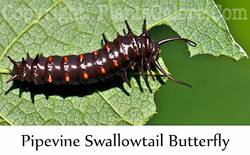|
 |
|
 |
|
 |
 |
 True
caterpillars, as opposed to
sawfly larvae,
are all members of the Lepodoptera Family of
insects. They all eventually develop into butterflies or
months. They are sometimes confused with
sawfly
larvae which are unrelated critters. True
caterpillars, as opposed to
sawfly larvae,
are all members of the Lepodoptera Family of
insects. They all eventually develop into butterflies or
months. They are sometimes confused with
sawfly
larvae which are unrelated critters.
Even though they are all
caterpillars, there are still several types found in the
home landscape:
|
|
 |
1.
Leaf Feeding Caterpillars
- Several species of caterpillars feed on the leaves
of ornamental trees and shrubs. In most cases, the
adults lay their eggs on the bark or other parts of
the tree in autumn or early spring. The larvae hatch
in the warmth of the sun and begin to feed. Later,
they pupate and turn into the adult moth or
butterfly which flies around and lays egg masses for
the following year's generation.
These types of
caterpillars would include the larval form of
gypsy moth, cankerworms and forest tent caterpillars. All
of them, including the confusingly named forest tent
caterpillar, do not form webbed nests or tents.
|
|
 |
2.
Tent Caterpillars and Fall
Webworms - As the name implies, these
caterpillars form a silky tent or web in the tree or
shrub during their larval stage. Generally, these
units are for shelter from predators and the
caterpillars may actually eat only within the
expanding web. After they have reached a certain
size, the caterpillars drop to the ground and pupate
in the soil before the adult emerges to lay eggs
again.
The Eastern tent
caterpillar appears in the spring and makes its tent
over the point where two branches merge (the
crotch). They feed into early summer primarily on
crabapples and then are gone for the season.
Generally, the do very minimal damage to the tree
and are mostly an aesthetic problem.
Fall webworms appear
in the late summer and form their tents or webs at
the tips of branches of may species of trees. Again,
they do minimal damage and are mostly an aesthetic
problem.
|
|
 |
3.
Bagworms - These
caterpillars form an individual bag for itself. As
they grow, so does the bag until it eventually stops
feeding and pupates. The female bagworm spends her
entire life inside her bag where she lays hundreds
of eggs. The eggs spend the winter in the bag and
hatch the following spring. Again, these are
generally more of an aesthetic problem.
|
 |
|
 |
 |
These insects feed on the tissue of
leaves and may eat the entire leaf or leave just the
veins of the leaf behind. In severe cases such as with
Gypsy moth caterpillars, the entire tree may be
defoliated while others such as Eastern tent
caterpillars generally do little damage to the overall
canopy.
Although even total
defoliation of deciduous trees (not evergreens) will not
kill the plant, repeated serious infestations over
several seasons can weaken the tree. Such trees are more
susceptible to other environmental stresses. Over a
period of years, this could lead to the death or
weakening of the tree.
|
 |
 |
 |
|
|
|
|
 |
 |
 |
Since these are
all true caterpillars (not sawfly larvae), they are
susceptible to the biological control product called
Bacillus thuringiensis (Bt). This is a nice product
since it only kills members of the Lepodoptera
Family. You do need to be sure that there are no
endangered species of moths or caterpillars in your area
before using Bt. It does not discriminate between "good"
caterpillars and "bad" caterpillars.
For small infestations or
small plants, you can sometimes hand pick the
caterpillars. Snip off webworm nests on small,
ornamental trees, if you can easily reach them. Pull
apart the nests of the Eastern tent caterpillars but do
NOT burn them off with a blow torch.
|
|
 |
|
Note: We
have provided some general information and
observations on this topic aimed at the home
gardener. Before you take
any serious action in your landscape, check
with your state's land grant university's
Cooperative
Extension
Service for the most current,
appropriate, localized recommendations. |
|
 |
|



